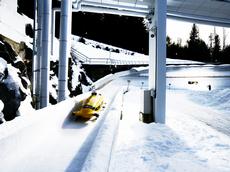Swiss bobsleigh teams on target for the Olympics
The World Cup races are over and the Citius bobsleigh has proved its worth: the two-man Swiss team even broke a track record at Königssee. In comparison the four-man bobsleigh had difficulties at the start. Even Ivo Rüegg, however, who has not driven a four-man Citius from the start, clearly didn't live up to expectations with his four-man bobsleigh.

On 11th January, an amazed Christian Reich reported on a “track record that would last forever” by Beat Hefti and Thomas Lamparter in the Citius two-man bobsleigh at Königssee the day before: “The lower part of the bobsleigh track is to be rebuilt in February 2010 so the track record of precisely 49 seconds will stay in the history books.” Reich is a former bobsleigh driver and is now the manager of the Citius bobsleigh project, in which ETH Zurich, the Swiss Bobsleigh Association and the industry have teamed up to build the Olympic bobsleigh for Vancouver.
Third start position secured
In spite of the delight at the track record, the Hefti team only managed 3rd place at Königssee, due to the bobsleigh touching the wall once too often in the first run. Prior to that, however, the team had won the gold medal in three World Cup races. The big Swiss favourites in the Citius two-man bobsleigh, pilots Beat Hefti and Ivo Rüegg, only missed out on a place on the podium once during the World Cup. It was in their home country of all places in the penultimate World Cup race in St. Moritz, where their successful run came to an end. Nevertheless there was still reason to celebrate: Daniel Schmid and Jürg Egger secured a third start place for the Swiss team with a Citius sleigh in the two-man bobsleigh in Whistler. Only the top three nations can send three teams to race. Alongside Switzerland, they are Germany and the USA.
Even though things didn't run so smoothly for the bobsleigh drivers in St. Moritz, the completion of the World Cup season, the European championship in Igls, Austria, made up for the disappointment: Around fourteen months after the Citius bobsleigh had made its first run on ice in Igls (http://www.ethlife.ethz.ch/archive_articles/081219_citius_eiskanal_su/index), Beat Hefti won the European championship title there in the Citius. Daniel Schmid finished third. Ivo Rüegg only made 9th position, although he still secured first position in the overall World Cup classification.
This year Swiss drivers have been better in the two-man bobsleigh than they have for a long time, which has pleased Christian Reich. For him it is evident that the two-man Citius bobsleigh has made a vital contribution to their success. The history of bobsleigh construction has shown that new innovations do not necessarily help the bobsleighs run faster. The Citius bobsleighs, however, seem to have managed that. The reason why the Swiss team is weaker in the four-man bobsleigh is due to the athletes, according to Reich. “The bobsleighs are good”, he’s convinced. The worse than expected results of Ivo Rüegg in the four-man bobsleigh, who was not racing in a Citius bobsleigh, seem to confirm this. Hefti also had his worst four-man race in St. Moritz, when he went back to his old bobsleigh instead of the Citius.
Optimising until the last
Although the athletes are almost on their way to the Olympics already, the scientists are still working in the background on making the bobsleigh even faster and better. Pascal Arnold, a graduate student of Christoph Glocker, who is a Professor at the Institute for Mechanical Systems, wishes to carry out further research into the optimum bobsleigh for his dissertation, even once the Olympic games have finished. For this he needs as much comparative data as possible from test drives. As a result, Glocker has stated his readiness to invest in further test drives during the last week of January in St. Moritz. “There we will test new suspension elements of the bobsleigh", says Arnold. “Only by doing so can we show to what extent the modifications are successful.”
On the way to quarantine
The further tests are also of benefit to the athletes. Reich tests the new parts in the Citius prototypes at the start of the week during test drives. At the end of the week they are then put up against the Citius bobsleighs, which have been used in the World Cup races. Afterwards there is theoretically still the opportunity to make a change or two. However, the bobsleighs will be flown to Vancouver at the start of February and will be under “quarantine” there until the Olympic Games. It will be exciting right up to the end to see which bobsleigh is flown to Vancouver for which team.
Five Citius two-man bobsleighs at the start in Whistler
The season was far less successful for the Swiss women
than it was for the Swiss men. For the pilots Sabina Hafner and
Fabienne Meyer the last race in Igls (Austria) was decisive to see whether they
would make it to Vancouver with their Citius bobsleigh. With a silver medal for Hafner and her brakewoman Hanne Schenk and 6th
place for Fabienne Meyer and Caroline Spahni, two women’s teams did manage to
qualify for the Olympics in the end. As a result it is expected that a total of five Citius two-man bobsleigh
teams will start in Whistler.
The Citius project
The Swiss Bobsleigh Federation has joined forces with ETH Zurich and several manufacturing companies to develop the 4- and 2-man bobs for the Winter Olympics in Vancouver. They include Abrasives, Sika, Indrohag, Georg Kaufmann, Quadrant, Bucher, Audi, Promec Estech, Ruag, V-Zug and Franz Marty. At ETH Zurich, 12 professors and more than 20 employees participated in the development.
Link:
More information about the Citius project:
http://www.ethlife.ethz.ch/archive_dossiers/dossier_citius_neu/index







READER COMMENTS